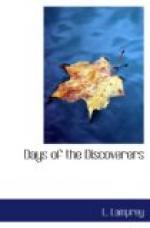The sagamore pines are dark
and tall
That guard the Norumbega wall.
When the clear brooks dance
to the flute of spring,
And veery and catbird of Klooskap
sing,
The Winag’mesuk for
one short hour
Come back for their token
of Klooskap’s power—
Moccasin Flower!
XII
GIFTS FROM NORUMBEGA
“What shall I bring thee then, from the world’s end, Reine Margot?” asked Alain Maclou. The small girl in the deep fireside recess of a Picardy castle-hall considered it gravely.
“There should be three gifts,” she said at last, “for so it always is in Mere Bastienne’s stories. I will have the shoes of silence, the girdle of fortune, and diamonds from Norumbega. Tell me again about Norumbega.”
“Nay, little one, I must go, to see after the lading of the ship. Fare thee well for this time,” and the young man bent his tall head above the hand of his seven-year-old lady. The graceful, quick-witted and imaginative child had been his pet and he her loyal servant these three years. It was understood between them that she was really the Queen of France, barred from her throne by the Salic Law that forbade any woman to rule that country in her own right. Some day he was to discover for her a kingdom beyond seas, in which she alone should reign. Of all the tales, marvelous, fanciful or tragic, which he or her old nurse had told her, she liked best the legend of Norumbega, the city in the wilderness which no explorer had ever found. Wherever French, Breton or English fishermen had become at all familiar with the Indians they heard of a city great and populous, with walls of stone, ruled by a king richer than any of their chiefs, but no two stories agreed on the location. Some had heard that it was an island, west of Cape Breton; others that it was on the bank of a great river to the southward. Maclou had seen at a fair one of the Indians brought to France ten years before in the Dauphine, and spoken to him. According to this Indian the chief town of his people was on an island in the mouth of a river where high gray walls of rock arose, longer and statelier than the walls of Dieppe. In describing these walls the Indian did not indeed say that they encircled the city, but no Frenchman could have imagined rock palisades built for any other purpose. On the other hand Maclou knew a pilot who had been caught in a storm and blown down the coast southwest from the fisheries, and he and his crew had seen, from ten or twelve leagues out at sea, white and shining battlements on the crest of a mountain far inland. When they asked their Indian guides what city it was the slaves trembled and showed fear, and declared that none of their people ever went there. Had only one man seen the glittering walls it might have been a vision, but they had all seen.




